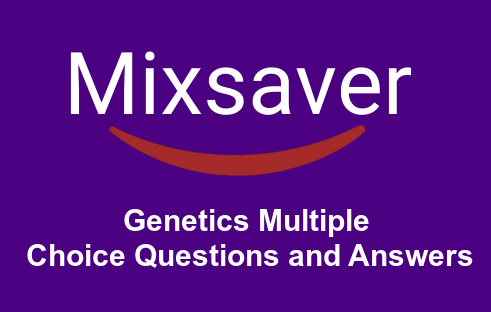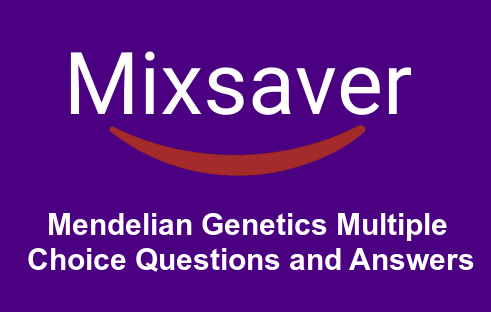Genetics NEET Questions | MCQ on Genetics For NEET
1. Law of Mendel which is not completely applicable is
(a) codominance
(b) law of dominance
(c) law of segregation
(d) law of independent assortment
Ans. a
2. In Mirabilis, a hybrid for red (RR) and white (rr) flower produces pink (Rr) flower. Again if this plant which pink flower is allowed to cross with the white flower. The expected phenotypic ratio will be
(a) red : pink (1: 1)
(b) red : white (3: 1)
(c) pink : white (1:1)
(d) red : pink : white (1:2: 1)
Ans. c
3. Who among these given below proposed the law of inheritance?
(a) Darwin
(b) Lamarck
(c) Mendel
(d) Correns Iso
Ans. c
4. Deduce the monohybrid ratio out of these proved by Mendel through his law.
(a) 3:1
(b) 9:7
(c) 1:2
(d) 9:3:3:1
Ans. a
5. If a homozygous red flowered plant is crossed with a homozygous white flowered plant, the offsprings produced will be
(a) all red flowered plant
(b) half red flowered plant
(c) half white flowered plant
(d) all white flowered plant ER
Ans. a
6. The back cross of F, hybrid with the recessive parent is called
(a) test cross
(b) monohybrid cross
(c) Punnett square cross
(d) dominant recessive cross
Ans. a
7. The first law of inheritance proposed by the Mendel was
(a) law of variation
(b) law of segregation
(c) law of inheritance
(d) law of independent assortment
Ans. b
Genetics Questions for NEET | Multiple Choice Questions on Genetics and Heredity pdf
8. Mendel’s principle of segregation was based on the separation of alleles in the garden pea during
(a) pollination
(b) flower formation
(c) seed formation
(d) embryonic development
Ans. a
9. Incomplete dominance is found in
(a) Pisum sativum
(b) Antirrhinum majus
(c) Both (a) and (b)
(d) None of these
Ans. b
10. A man with blood group B marries a woman with blood group A and their child is having group B. What is the genotype of the child?
(a) IA IB
(b) IB IB
(c) IB i
(d) IA i
Ans. c
11. If an individual with type O blood mates with an individual with type AB blood, what will be the possible blood types of their offspring?
(a) A
(b) B
(c) AB
(d) A and B
Ans. d
12. Mendel’s law of segregation, as applied to the behaviour of chromosomes in meiosis means that
(a) pairing of homologous will convert one allele into he leading to separation of the types
(b) alleles of single gene separate from each other homologous separate in meiosis-l
(c) genes on the same chromosome will show Fo recombination
(d) alleles of a gene will be linked and passed on together through meiosis
Ans. b
13. Aman is heterozygous ‘B/b’ for one autosomal gene and he carries a recessive X-linked allele ‘d’. What proportion of his sperm will be bd?
(a) 1/4
(b) 1/8
(c) 1/16
(d) 1/2
Ans. d
14. If a man with blood group AB marries a woman of blood group A whose father was of blood group 0, to what different blood groups can this man and woman expect their children to belong?
(a) A, AB and B
(b) A and AB
(c) AB and O
(d) A, O and B
Ans. a
15. In guinea pig, black coat colour is a dominant over the white which is a recessive trait. A black female is test crossed, producing six black offsprings. The probability that a heterozygous black would do this by chance alone is approximately.
(a) 50%
(b) 25%
(c) 1%
(d) Cannot be determined from the above information
Ans. a
Mendelian Genetics Multiple Choice Questions with Answers pdf | MCQ on Genetics with Answers
16. What are the minimum progeny population sizes allowing for random union of all kinds of gametes from AaBbCc parent?
(a) 64
(b) 32
(c) 16
(d) 8
Ans. a
17. Why would you predict that half of the human bodies born will be males and half will be females?
(a) Because of the segregation of the X and Y-chromosomes during male meiosis
(b) Because of the segregation of the X-chromosomes during female meiosis
(c) Because all eggs contain an X-chromosome
(d) Because on average, one half of all eggs produce female
Ans. a
18. Asymmetry between reciprocal crosses is seen in
(a) pleiotropy
(b) sex-linked inheritance
(c) interaction of genes
(d) autosomal inheritance
Ans. b
19. Which of the following is not true about autosomal dominant traits?
(a)Every affected person should have at least one affected parent
(b) Males and fomales should be equally often affected
(c) An affected person has a 50% change of transmiting the dominart alleie to each offspring
(d) All the daughters of an aftected male will be affected but none of the sons
Ans. d
20. Albinism is a recessive human trait. If a normal couple roduces an albino child. Assume the probability that heir next child will also be an albino?
(a) 1/4
(b) 1/8
(c) 1/16
(d) 1/64
Ans. a
21. The genetic genotype and phenotype were introduced by
(a) Bateson
(b) Darwin
(c) Johannsen
(d) Mendel
Ans. c
22. ABO blood group is one of the good example for which the following?
(a) Epistasis
(b) Codominance
(c) Pleiotropy
(d) Incomplete dominance
Ans. b
23. Cystic fibrosis is a hereditary disease that affects the respiratory and digestive systems. Cystic fibrosis occurs when two recessive genes (cc) are present. A person with one allele for cystic fibrosis is called a carrier (Cc) of the disease. If mother is a carrier of the disease and father is homozygous dominant, what are chances that their child will be a carrier of cystic fibrosis?
(a) 25%
(b) 50%
(c) 75%
(d) 100%
Ans. b
Mendelian Genetics Questions and Answers pdf | Genetics mcq pdf | Mendelian Genetics problems with answers pdf
24. Pair of contrasting characters controlling the same trait is called
(a) factors
(b) alleles
(c) alloloci
(d) paramorphs
Ans. b
25. The term ‘gene’ was introduced by
(a) Mendel
(b) Bateson
(c) Morgan
(d) Johannsen
Ans. d
26. Alleles of a gene are found on
(a) same chromosome
(b) any chromosome
(c) homologous chromosome
(d) non-homologous chromosome
Ans. c
28. For finding the different types of gametes produced by genotype AaBb, it should be crossed with genotype
(a) AABB
(b) aabb
(c) AaBb
(d) aaBB
Ans. b
29. Total number of progeny of a dihybrid cross is 1280 in F-generation. How many recombinants are?
(a) 240
(b) 360
(c) 480
(d) 720
Ans. c
30. How many rypes of gametes are found in F1 progeny of cross between AABBCC of aabbec?
(a) 3
(b) 8
(c) 27
(d) 64
Ans. b
MCQ on molecular basis of inheritance
31. Identify the phenomenon which masks interaction of genest
(a) Recessiveness
(b) Dominance
(c) Epistasis
(d) Pleotropy
Ans. c
32. If the cell of an organism is heterozygous for two pairs of genes represented by Aa, Bb which undergoes meiosis, then the possible genotypic combination of gametes will be
(a) AB, aB, Ab ab
(b) AB, ab
(c) Aa, Bb
(d) None of these
Ans. a
33. Pure line is connected with the development of
(a) complete hormozygosity
(b) complete heterozygosity
(c) homazygosiny and linkage
(d) heterozygosity and linkage
Ans. a
34. Segregation of genes takes place during
(a) metaphase
(b) araphase
(c) prophase
(d) zygote formation
Ans. b
36. If fur colour in mice is caused by the following: B= black and b = brown, choose the genotype for the organism, which will have brown fur?
(a) BB
(b) bB
(c) bb
(d) Either (a) or (b)
Ans. c
MCQ on genetics with answers pdf
37. What is the major advantage of using a Punnett square?
(a) Show all gametic combinations
(b) Show genotyplc ratios
(c) Show all phenolypic ratios
(d) All of the above
Ans. d
38. From a single ear of corn, a farmer planted 200 kernels which produced 140 tall and 40 dwarf plants. The genotype of these offsprings are most likely
(a) TT, Tt and t
(b) TT and tt
(c) TT and Tt
(d) tt and t
Ans. a
39. Phenotype is
(a) the genetic make up of an individual
(b) the same for parent and offspring
(c) the account of physiological activities
(d) the apr srance of an individual
Ans. d
40. If an individual has a recessive phenotype for a given trait, the genotype must be
(a) heterozygous
(b) homozygous recessive
(c) homozygous dominant
(d) either homozygous recessive or heterozygous
Ans. b
41. What is the genotype for a short pea plant?
(a) tt
(b) Tt
(c) TT
(d) Cannot be determined
Ans. a
Principle of inheritance and variation mcqs
42. Which concept is not associated with the work of Mendel?
(a) Dominance
(b) Independent assortment
(c) Use and misuse
(d) Segregation
Ans. c
43. Using the results of his experiments with pea plant crosses, Gregor Mendel discovered the.
(a) principles of dominance, segregation and independent assortment
(b) intermediate inheritance and gene linkage
(c) pea plants develop mutations after exposure to radiation
(d) DNA is involved in the inheritance of dominant traits
Ans. a
44. When two heterozygous tall plants are crossed, some short plants appear in the offspring. The appearance of these short plants illustrates
(a) segregation and recombination
(b) intermediate inheritance
(c) crossing over and differentiation
(d) codominant inheritance
Ans. a
45. In a certain variety of chicken, the genes for black feather colour and the genes for white feather colour are codominant. This variety of chicken will most likely to have
(a) three possible phenotypes for feather colour
(b) only two genotypes for feather colour
(c) white feather colour only
(d) biack feather colour only
Ans. a
46. How many genetically different kinds of gametes will an individual with genotype AAbb produce?
(a) One
(b) Two
(c) Three
(d) Four
Ans. a
47. How did Mendel’s studies in genetics differ from earlier studies of breeding and inheritance?
(a) Mendel worked with plants; earlier studies used animals
(b) Mendel was able to explain the ‘blending’ hypothesis
(c) Mendel’s work was more quantitative
(d) Mendel worked with wild species, not the domesticater ones
Ans. b
48. If an individual of genotype AaBbCcDd is test crossed, how many different phenotypes can appear in their progeny
(a) 4
(b) 12
(c) 8
(d) 16
Ans. d
49. In humans, MN blood group is an example of
(a) codominance
(b) a dihybrid
(c) pleiotropy
(d) incomplete dominance
Ans. a
50. According to Mendel’s law of segregation,
(a) there is a 50% probability that a gamete will get a dominant allele
(b) gene pairs segregate independently of other genes in the gamete formation
(c) allele pairs do not separate in gamete formation
(d) the laws of probability determine the gamete formation
Ans. b
51. Violet flower colour in garden pea is
(a) recessive
(b) dominant
(c) epistatis
(d) complementary
Ans. b
52. When two or more non-allelic gene pairs affect the same character in the same way, this is called
(a) polygenic inheritance
(b) pleiotropy
(c) total penetrance
(d) additive expressivity
Ans. a
53. Diseases caused by pleiotropic genes are
(a) syndromes
(b) reversible by diet therapy
(c) reversible by gene therapy
(d) extremely rare
Ans. a
54. How many different kinds of female gametes are produce by the F; offsprings from a cross between a pure strain plants with yellow peas and a pure strain of plants with green peas?
(a) One
(b) Two
(c) Four
(d) Eight
Ans. b
55. An organism with two copies of the same allele is
(a) homozygous for that trait
(b) homologous for the allee
(c) heterozygous for that trait
(d) heterologous for the allele
Ans. a





